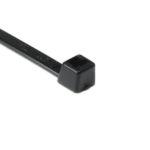In the world of cable management, size does matter. Especially when you're dealing with high-tension and bulky cable arrangements, extra large cable ties offer a durable and efficient solution. With their ability to withstand extreme conditions and high load capacities, they're becoming an industry standard for professionals in the cable tools sector.
But why the sudden surge in demand for these mega-sized fasteners? Today, we'll explore the utility of extra large cable ties, their ideal applications, and tips for selecting the right kind for your needs. Buckle up, because these aren't your garden-variety zip ties.
What Sets Extra Large Cable Ties Apart
When it comes to cable ties, it's easy to dismiss them as simple, one-use tools. But extra large cable ties are far more versatile and robust than their smaller counterparts. They often boast higher tensile strengths and can endure harsh environmental conditions, making them the go-to for heavy-duty applications.
These hefty fasteners also accommodate larger bundle diameters. The sheer length and width provide flexibility, enabling easier handling. In essence, they're designed to meet the more demanding requirements of industrial settings.
Ideal Applications for Extra Large Cable Ties
These aren't your run-of-the-mill zip ties that you'd use for light cable management. Extra large cable ties are better suited for complex projects that require maximum durability. Whether it's in construction, manufacturing, or even marine environments, these fasteners shine where standard cable ties would falter.
Think about scenarios like bundling steel cables on a bridge or securing electrical wiring in a ship's engine room. They need to bear weight and resist environmental factors like saltwater and intense heat. In such demanding settings, a regular cable tie just won't cut it.
How to Choose the Right Type
Selecting the right extra large cable tie for your application isn't a one-size-fits-all endeavor. Various factors come into play, like material, tensile strength, and the overall dimensions. For instance, stainless steel ties offer better resistance to corrosive environments but might be overkill for interior applications.
Furthermore, keep an eye on the tie's load capacity. Ensure that it's capable of holding the weight of the cables without risking a snap. It's always prudent to test a sample before committing to a bulk purchase, because the last thing you want is a cable management catastrophe.
A Word on Cost and ROI
Budget considerations are crucial when opting for extra large cable ties. Given their specialized nature, they often come at a premium. However, their durability often leads to long-term cost savings. The up-front investment can result in fewer replacements and reduced maintenance hours.
So while they might be pricier initially, think of them as a long-term investment. When the stakes are high and failure is not an option, extra large cable ties offer a peace of mind that's well worth the price tag.
HellermannTyton Cable Ties: A Comparative Review and FAQs
In the ever-changing landscape of cable tools, HellermannTyton consistently delivers robust solutions, especially when it comes to cable ties. While all HellermannTyton cable ties are designed to withstand demanding applications, it's important to pick the right one for your specific needs. Today, we'll review three different products to help you make an informed choice.
HellermannTyton T150M0UVX2: The Heavy-Duty Performer
HellermannTyton T150M0UVX2 offers unparalleled strength with a tensile strength of 175lb, making it an ideal choice for heavy-duty tasks. It comes in a UV-resistant polyamide 6.6 material, promising extended longevity even under direct sunlight.
The tie measures 21 inches in length and 0.35 inches in width. This gives you ample room for managing those thick bundles of cables, especially in industrial settings. A set of 25 will run you $12.95, a worthy investment for its rugged capabilities.
HellermannTyton T50R9PPC2: The Chemical Resistant Pick
When you need resistance against chemicals and salts, HellermannTyton’s T50R9PPC2 becomes your go-to. Made of polypropylene, it's perfectly suited for harsh environments. It boasts a tensile strength of 25lb and measures 8 inches in length.
However, don’t let the natural color fool you. This cable tie is as durable as they come, especially in resisting corrosive elements. It's available in packages of 100 for $21.35, making it cost-effective for projects requiring a large number of ties.
HellermannTyton T50R0HSC2: The High-Temp Specialist
Heat is no match for this cable tie. Designed to withstand temperatures up to +257°F, the T50R0HSC2 is tailored for high-temperature applications. It has a tensile strength of 50lb and is 8 inches long, much like the T50R9PPC2.
Its heat-stabilized polyamide material ensures that it maintains its integrity even in extreme thermal conditions. Available in UV black and a package of 100 for $21.95, this cable tie offers high value for its specialized capabilities.
FAQs
A: Yes, all three cable ties mentioned in this article are RoHS compliant.
A: HellermannTyton T150M0UVX2 is specifically designed to be UV-resistant, making it ideal for outdoor applications.
A: They vary. The T150M0UVX2 operates between -40°F to +185°F, the T50R9PPC2 between -40°F to +239°F, and the T50R0HSC2 between -40°F to +257°F.
A: Only the HellermannTyton T50R0HSC2 meets the US MIL SPEC MIL 53421 standard.
Wrapping Up
In summary, extra large cable ties are the unsung heroes of heavy-duty cable management. With their robust design, wide-ranging applications, and the value they offer, they're an indispensable tool for industry professionals.
Ready to dive deeper? Don't miss our latest blog post on the most innovative cable tools of 2023: Metal Wire Ties: The Backbone of Cable Management




